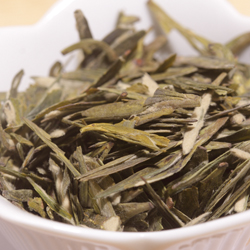 |
| Pu-erh Tuo Cha (Bird's Nest Nugget) |
China's Yunnan
province is considered to be the birthplace of tea and the origin of Pu-erh.
Wild tea trees, some of them hundreds of years old, can be found in the
tropical forests of Xishuangbanna. This region offers ideal conditions for the
cultivation of tea: a temperate, moist climate and a rich soil with an
abundance of organic materials.
 |
| Yunnan Tea Forest |
The prized tea
of Yunnan Province is Pu-erh, made from tea plants native to its forests and
jungles. The tea was named after the town of Pu-erh, an important trading
center and the beginning of the ancient Tea Road which connected China's
southwest to Tibet and onward to Nepal and India. Pu-erh tea is one of the
oldest types of tea and traces its history to the Tang dynasty (618 - 907).
During that time, tea was compressed into cakes of various sizes, then boiled
in salt water with added flavorings such as ginger, onion and orange zest to
create a tea "soup". Tea was also shaped into bricks to make it
easier to transport on horseback for the long and arduous journey to Tibet.
Pu-erh is a
fermented tea. The fermentation occurs through a process of microbial activity,
similar broadly to the production of wine, vinegar, yogurt and soy sauce. Pu-erh
tea can be divided in two types: raw (“sheng”) and ripe (“shu”). Both types of
Pu-erh are processed similarly in the beginning – leaves are picked, withered
outdoors for several hours, fired at low temperature and then sun dried. The
result is "maocha" or unfinished tea. After the maocha stage, the
processing methods diverge.
Sheng Pu-erh
leaves are left alone to age naturally over time. In the humidity of China,
naturally occurring microbes in the leaf break down to new substances,
resulting in changes to the flavor of the tea.
Shu Pu-erh tea is
made by accelerating the fermentation the "maocha" in a controlled
process using added heat and humidity,
similar to composting. The unfinished leaves are gathered into piles where the
heat generated kills off undesirable microbes and promotes the growth of
beneficial microbes. The result of this fermentation process is a tea like no
other - known for its earthy, mellow flavors and sweet lingering aftertaste.
Both Sheng and Shu Pu-erh teas can be kept in
a loose form or compressed into various shapes such as cakes, bricks and
nuggets.
Pu-erh tea is
recognized for its digestive properties. Due to its microbial aging process,
Pu-erh naturally helps to break down fats and grease in the stomach.
How to Prepare Pu-erh Tea
Pu-erh tea is best prepared in the gongfu style using either a small clay teapot or porcelain gaiwan, This method allows for multiple infusions, bringing different flavors with each steeping.
For loose-leaf Pu-erh, add about 1 tablespoon to the pot. If using a tuo cha (nugget), add one piece to the pot. Heat water to boiling. First, rinse the leaves for about 5 seconds and discard the rinse water. Add more hot water and let the tea steep 1 minute for the first infusion. Steep 30 seconds for the second infusion and 45 seconds for the third infusion. Steep subsequent infusions about 2 minutes. Most Pu-erh teas can be re-steeped 5-6 times in this manner.






















